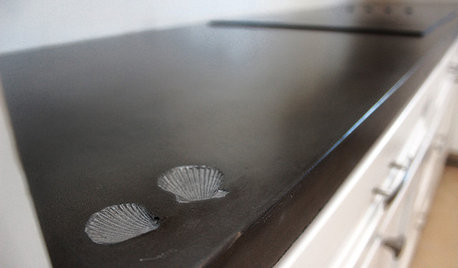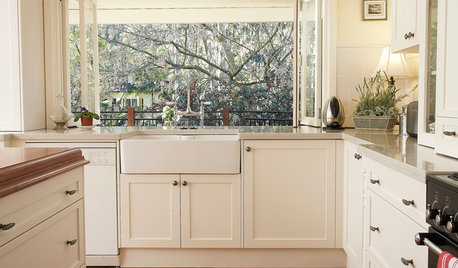QUESTION
I have been reading some stuff about concrete, and since I have lung problems (chronic bronchitis)I wonder what kind of mask or respirator I should use. One article said to use something that is rated for silica because of the lung disease silica can cause (silicosis). It scares me! What are all of you doing about this?
ANSWER
GOOD QUESTION!
Hopefully everyone's wearing masks approved for use with silica - I am!
Wear household cleaning gloves (like Platex Living gloves) when handling and mixing concrete and hypertufa. You can switch to lighter weight disposable gloves after mixing. Wet concrete and hypertufa are caustic to the skin and moist membranes (like your airways and eyes).
Wear eye protection!
We have mentioned all this before, all the instructions other members have submitted remind people to wear safety equipment, so I'm assuming that folks are doing just that. However, just in case... *climbs up on soapbox...*
ANYONE working with portland cement, silica sand, silicon dioxide, silica fume, vermiculite, perlite, natural pigments and oxides, paints, sealers, admixes, or any other substances has a PERSONAL RESPONSIBILITY to acquaint themselves with the chemical properties, safety and environmental issues of those substances.
Start by READING THE LABELS - the ENTIRE label!! Then read the MSDS sheets. People DO work with and around these products every day, but they are NOT benign and should NOT be used carelessly. You SHOULD be concerned about being around products like this, especially if you have an existing health issue. Use good sense, KNOW and FOLLOW safety procedures. Check out the MSDS sheet for concrete.
When finishing (wire brushing, carving, sanding, etc.) cementious products (concrete & hypertufa), keep the object WET so that no dust is created. Wear the mask anyway - just in case. If you are working in an enclosed area - basement, garage, shed, be sure to use GOOD ventilation, a particulate air filter, and put washable mats at the entrance to living areas to avoid tracking dust into your living environment.
Use plastic sheeting or bags whenever possible so that cleaning up mostly consists of carefully gathering the protective material and throwing it away. Vacuum rather than sweep.
Wear protective clothing, especially when finishing objects. A lot of dust goes right into your clothing, so shower, change and launder immediately after working. If you do a lot of this work, have a couple of "work outfits" so you are not trashing and contaminating all your clothes. Those disposable paper jump suits are the hot set-up and are used extensively in the ornamental concrete industry.
When transferring dry materials (pouring into storage buckets, measuring for mixing, etc.), create as little dust as possible. FAST = DUMPING = DUST.
Instead of DUMPING a load of sand (crystalline silica dust) or portland cement into a mixing tub, PLACE the measuring container into the mixing container as close to the bottom as possible and SLOWLY SLIDE the material out of the measuring container into the mixing tub to create minimal dust. Measure your powdery ingredients into the mixing tub first, then add the heavier particulate matter (sand, perlite, vermiculite, etc.) on top of the cement, etc.
When transferring ingredients from paper bags into storage containers, make a 6"-8" cut in the top of the bag and place the open end into the storage bucket. SLOWLY empty the bag into the container, raising the bag slightly as the material fills the container. Don't worry about trying to shake every little grain out of the bag! The savings is NOT worth the dust created!
TRANSFER BULK MATERIALS TO STORAGE CONTAINERS OUTDOORS, not in your house, basement, shed or garage, then move the smaller storage containers wherever is convenient for you. Hauling the storage containers to your work area is good exercise!
Working with these products does require diligent adherence to safety, health and environmental consideration, but there is no reason to be afraid to use them.
USE COMMON SENSE!!!
If you are still concerned, discuss your concerns with your doctor who might have more specific advice for you.
Respect and follow good safety procedures and HAVE FUN.
Rock On! :)
***********************************************************
Definitely use something that is better than those "surgical" masks you see people wearing to mow the lawn.
Read the label on the masks to see what they are certified for, and change cartridges as needed.
Also, to minimize dust production, pre-moisten the perlite/vermiculite/peat. Put some of the damp stuff into the mixing container and make a "volcano". Gently put the Portland cement and sand into the crater and top with the rest of the other pre-moistened ingredients.
***********************************************************
I've found that when you're making 'tufa, if you mix your first two ingredients, (Sand, peat, etc.) really well, BEFORE you add your cement, you greatly minimize the stirring up of cement dust. This is especially helpful when you're mixing large quanities in a wheelbarrow, for example.
***********************************************************
I have my "concrete clothes" I slip into when I start to work with the product, take them off and shower immediately after, I can feel the stuff in my hair, dusting my glasses, always wear the approved mask, have now evolved to double gloving for my hands.
***********************************************************
QUESTION
Are masks necessary even when working outside?
ANSWER
YES, they are. Cement hardens from a chemical reaction between water and cement dust. Your lungs are super-moist and that cement dust is very, very fine - you don't want to find out the hard way how they are going to work together. I do all my work outside and always wear a mask. You only need your mask while you are mixing the dry ingredients. Once they are wet you can set the mask aside to do the actual molding and such.
************************************************************
MORE SAFETY ISSUES
As I was scraping away on the inside of a pot yesterday, I had a *near miss* I wanted to share. Normally, I wear glasses, so eye protection is covered for most things. But, when I'm working on pots, the glasses often come off so I can see close up. I was scraping with one of those big utility knives with the breakaway blades, when the blade suddenly broke and whistled past my eye. Actually felt the wind of it on my skin! I dodged a bullet that time! I realized that the safety errors I had made are rather common, so I thought I'd share my brainless moment and hope it saves someone an injury.
When we're using tools (especially makeshift tools not designed for the purpose for which we're using them) scraping and particularly sculpting, gotta wear dem goggles! They make 'em in all colors to complement the most colorful of 'tufa outfits, so fashion is no excuse to pass 'em up! I'm gettin' some hot pink ones for Mother's Day! Elton John, eat my dust!
************************************************************
I had a close call with a machete a few weeks back... kept slipping out of my hand. I took it back and am gonna look for one with a closed loop handle next time. Safety FIRST, fur shur!
*************************************************************
Another tool to consider using eye protection is a hand held wire brush. Some people use the brush to ruff up the tufa. The wires do brake off and become flying missiles. Happened to me as a kid cleaning an ax head of rust, didn't know I had pieces of wire in my eye until the next day when I couldn't open my eye lids. Another trip to the hospital in my youth.
*************************************************************
And it's not just the tools you have to worry about. I've gotton small bits of tufa mix flung into my eye as I was scraping with a wire brush - it hurt like h***. And then two weeks ago I was dipping cement out of the bag into my measuring containor when I caught it just right and *whoof* a cloud of cement dust comes flying up out of the bag and right into my face. Fortunately the hose was nearby and I managed to flush my eyes out before any damage could occur. I ALWAYS wear my goggles now when doing anything other than the actual molding.
*************************************************************
The very same thing happened to me five days ago - there was a hole in a bag of dry concrete mix and as I was moving it the same thing happened - WHOOF - a cloud of dust came out and into my face.
My eye got worse and worse and before the day was out I had to go to the local clinic. The young doctor rolled the eyelid up and found a tiny piece of grit EMBEDDED in the eyelid. Every time I blinked it was scratching the eye's cornea.....
The dry dust from these mixes is quite corrosive and it must damage your lungs too if you breathe it in. I reckon that not just goggles, but a SARS type face mask are both good ideas.
*************************************************************
More than a SARS mask - an ANSI approved mask for free silica!
The "bag poof" phenomena is another reason I store my cement in plastic bags inside of buckets - I can deal with powdery stuff in plastic bags, but those heavy paper bags do unexpected things with cement! Portland cement is deceiving - something that is so darned heavy to move around SHOULD NOT be light enough to poof in your face!!! One of life's little contradictions, 'tufa style!!!
*************************************************************
REGARDING GLOVES
I had a very successful day Sunday working on the water fall in hypertufa. My gloves failed after the first hour, and I did not heed your advice and continiued bare handed for four more hours. Monday I could not use my hands at all. Very painful!!!
***********************************************************
I was really good about all the safety precautions when I mixed and made my totem. However, when I unmolded the beads after 22 hours I didn't wear gloves. I spent about 10-15 minutes filing off the chunky edges till I realized the fingers on my left hand (holding the beads) were being eaten through. My pinky was actually bleeding. Won't make that mistake again; ouch.
***********************************************************













Related Discussions
How to tell if a download is safe? & related internet safety ?
Q
Info about doctor, hospital, health issues by emergency room doc
Q
What should I know about installing a subpanel?
Q
Garden Safety: what you know and sources
Q